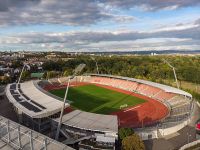Auestadion is a multi-use stadium in Kassel, Germany close to the Karlsaue park. It is used mainly for football matches and athletic events and is the home stadium of KSV Hessen Kassel. The stadium is able to hold 18,737 people with 8,700 seats and standing terraces. It was opened on 23 August 1953, and renovated between 1983-1993 and between 2003 and 2010. It is the largest stadium in Northern Hesse.
History
Construction
The City of Kassel first started considering a new stadium being built on the eventual Auestadion site in 1948. The site had previously been used as a parade ground. Construction started on a new stadium in 1950. The foundations for the new stadium grandstand was built from 100,000 m3 of World War II debris from the city centre of Kassel. The grandstand was built to hold 2,200 fans. It had a cantilevered steel roof, enabling uninterrupted views of the playing surface from the stand for the supporters. It was only the second stadium in Germany to incorporate a cantilevered roof, following the Heinz Hilten designed Rosenaustadion in Augsburg that was built two years prior in 1951. In additional to the roof and seating capacity, the grandstand incorporated glazed exterior walls, a dedicated section for the media and change rooms for players and officials. A six lane running track made out of red cinder was installed around the outside of the football pitch.
Opening
On 23 August 1953, the Auestadion was officially opened by Hessian Prime Minister Georg-August Zinn in front of 20,000 people. A top division football match between Auestadian's first tenants KSV Hessen Kassel and Bavarian opponents Viktoria Aschaffenburg was played to inaugurate the opening. Hessen Kassel lost the match 2–1. The athletics facilities at the stadium was completed in 1956. On 17 June 1956, to mark the completion, an inauguration ceremony was held along with an athletics festival attended by 12,000 spectators. Local and national athletes turned out for the
